Aloe vera is one of the most popular botanical skincare ingredients but not many people realize its full potential.
For example, you may know it as the plant that can treat burns, but did you know that aloe gel also has major anti-aging properties?
In fact, this succulent has had so many uses throughout the years that it has sometimes been regarded as a “miracle plant.” This is partly because there are many fantastic benefits of aloe for skin but also because it can be used internally to support your whole body.
Here’s more about the wonder plant that is aloe and how it can boost your skin and health.
The Amazing Aloe Plant
Aloe is a name used for both a plant and a product. It can refer to the aloe plant itself: Aloe barbadensis miller, a succulent native to Africa. Or it can refer to the sap, gel, or juice that is harvested from the thick leaves of the plant.
Botanically speaking, there are about 420 different species of aloe, most of which grow natively in Africa. However, for health and beauty, Aloe vera is the most used type and what you would expect to get if you bought an aloe plant for your home.
Despite origins in Africa, aloe has long been valued all over the world. It has featured in Chinese medicine and traditional Indian medicine and also became rapidly popular in western countries.
When you learn more about the makeup of aloe, it isn’t surprising that so many cultures have valued this plant. Research shows that there are over 130 different plant compounds within aloe and possibly more. It’s also packed full of a wide array of vitamins, minerals, and other nutrients (more on that next).
To add to this, the gel within the leaves is made up of about 98-99% water, which provides extra hydration to your skin and body.
Outstanding Nutrition
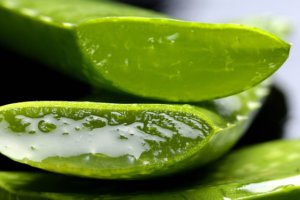
One of the reasons for the powerful benefits of aloe for skin and health is the impressive array of nutrients it contains.
To start with, aloe contains the antioxidant vitamins A, C, and E— all of which are incredibly important for healthy skin. It also has vitamin B12 and folic acid, which are important for energy and healthy blood cells.
The trace minerals in aloe are almost too many to list. Some of the main ones include magnesium, potassium, calcium, manganese, copper, selenium, chromium, and zinc. Many of these are essential and needed by your body for a wide range of functions.
Surprisingly, aloe vera is also an excellent source of amino acids, the building blocks for proteins. The gel contains 20 different amino acids needed by the human body and 7 out of the 9 amino acids that are considered essential (meaning your body can’t produce them).
Aloe vera is also rich in enzymes, including ones that aid digestion, and compounds known as anthraquinones. Anthraquinones can act as a laxative and also have antibacterial and antiviral properties.
With all these nutrients and compounds, it’s really no surprise that aloe is such an amazing substance!
Top Benefits of Aloe for Skin
Effective for Burns (and Sunburn)
The most famous use for aloe is undoubtedly to help burned skin recover. It has been used for this purpose for thousands of years, and its effectiveness is now confirmed in studies.
Research shows that aloe vera applied topically can enhance the healing process of burns and other skin wounds. It has been found most effective for first- and second-degree burns, even more so than other common treatments like petroleum jelly, silver sulfadiazine ointment, and framycetin (antibiotic) cream.
The same research also indicated that aloe helped prevent infection and itchiness in the wounded areas AND was effective for other types of skin injuries— sores, ulcers, surgical wounds, frostbite, and certain infections.
Of course, you don’t have to have a serious burn to benefit from aloe gel. It’s soothing for sunburned skin as well, and there’s some indication that it may have a protective effect against radiation damage (from UV rays).
May Boost Collagen & Improve the Appearance of Wrinkles
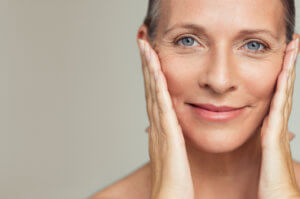
One of the top anti-aging benefits of aloe for skin is that it may increase collagen synthesis.
Collagen is the most abundant protein found in your skin and is also a major building-block for muscles, tendons, and ligaments. It could well be considered an anti-aging protein because it plays a big role in keeping your skin looking firm, youthful, and wrinkle-free.
As you may know, collagen production starts declining in your body with age. Finding ways to boost its production is critical for maintaining healthy, young-looking skin.
At least one study has shown that aloe gel can increase collagen production and improve wrinkles and skin elasticity. This was when participants took the gel internally, but other studies indicate that it may improve wrinkles when used topically as well.
May Fade the Appearance of Dark Spots
Another common sign of skin aging is the appearance of dark spots (also known as age spots or hyperpigmentation). They typically form as the result of too much sun exposure but can also come from the fading of acne scars and the like.
If you’ve ever been frustrated trying to get rid of dark spots, you aren’t alone. They can be very stubborn and annoyingly resist your best efforts to get rid of them.
However, one compound in aloe known as aloesin may be able to help. Some research has shown that applying aloesin topically can help fade the look of hyperpigmentation from both UV-induced damage and acne. A separate study found that aloesin may also help inhibit the formation of dark spots.
Research on aloesin is still continuing, but some experts believe it could be an excellent natural lightener for hyperpigmentation.
Boosts Skin Hydration
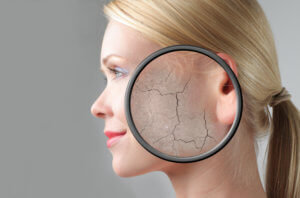
Since aloe gel is made up of 98-99% water, it’s not much of a surprise that it can add extra hydration to your skin.
Of course, water on its own doesn’t hydrate skin (it mostly evaporates), but aloe has compounds that help moisture “stick”.
These compounds are known as mucopolysaccharides and are a type of sugar found in aloe. They help bind the moisture from the gel to your skin instead of letting it evaporate into the air. This has a hydrating effect and also helps to soften skin.
Other studies have confirmed the moisturizing benefits of aloe for skin. One found specifically that topical use increases the water content of the outermost layer of your skin (the stratum corneum), particularly when aloe is used consistently for a few weeks.
Helps Exfoliate & Renew Skin
Another component of aloe vera gel that might surprise you is salicylic acid.
Salicylic acid is most often associated with acne products where it’s frequently used as the active ingredient. It’s considered a beta hydroxy acid (BHA) and is used to exfoliate skin, clear pores, and encourage skin cells to regenerate.
Most often, salicylic acid is synthetically made, but it’s also naturally present in several plant sources, including willow bark, meadowsweet, and (of course) aloe.
Because the amount of salicylic acid in aloe is relatively low, your skin gets the benefits of mild exfoliation without much risk of over-exfoliation. Basically, it gently helps with the removal of dead skin cells and promotes regeneration without the potential irritation that comes along with a heavy exfoliator.
Calms Inflamed or Irritated-Looking Skin
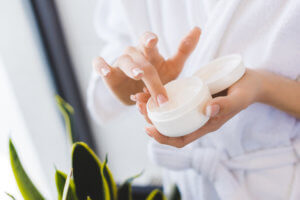
Certain compounds in aloe, like aloin, have demonstrated anti-inflammatory properties in studies. This is most likely a large part of the reason why aloe gel has such a soothing and calming effect on irritated skin.
You already know how effective aloe is for burns and wounds, but it also has a lot of potential for easing itchy and inflammatory skin issues.
To give you an idea, research from the last 30+ years has consistently shown that topical application of aloe can help ease psoriasis, dermatitis, and similar skin conditions. In fact, when aloe was used as an extract in a cream, it had an 83.3% success rate at curing psoriasis (compared to 6.6% in the placebo group) in one small study.
Aloe also has benefits for calming minor skin inflammation and redness associated with age or sun damage. However, as the previous study noted, it appears to be more effective for damaged/irritated skin when used in a formulated product— like a cream— than on its own.
Has Acne-Fighting Potential
Aloe gel has a few specific properties that make it a potential acne fighter.
As mentioned in the previous section, compounds like aloin have an anti-inflammatory effect that may help to calm breakouts. The salicylic acid in aloe also helps combat acne by clearing away dead skin cells and keeping pores from getting clogged.
In addition, aloe has antibacterial properties and contains minerals (like zinc) that are known to help reduce acne.
Now, it’s important to point out that aloe is not a strong acne fighter like a medicated or concentrated product would be. It simply doesn’t contain a high enough amount of salicylic acid or antibacterial compounds for that.
However, research does show that it may be able to enhance the effects of other acne treatments.
One key example of this is a study from 2014. Participants used either a tretinoin cream (common acne treatment) or a combination of tretinoin and aloe gel. The results showed that the combination was significantly more effective at reducing acne lesions than the tretinoin alone.
Protective, Anti-Aging Power

You already know that aloe can aid collagen production, which is a huge anti-aging benefit. It also improves skin hydration— something very important for minimizing signs of aging like fine lines and wrinkles.
In addition to these great benefits of aloe for skin, research has shown that other aloe compounds can stimulate the production of hyaluronic acid. Hyaluronic acid is a naturally occurring substance in your skin. It helps keep skin hydrated, elastic, and youthful-looking.
Just like with collagen, hyaluronic acid production decreases with age, so increasing it naturally is key for a youthful complexion.
You’ll also be happy to hear that the antioxidants in aloe (particularly vitamins C and E) have powerful protective properties for your skin. They work together to help prevent signs of premature aging from free radical and UV damage.
Other Significant Health Benefits of Aloe
Clearly, the benefits of aloe for skin are truly outstanding, but you might be wondering what else it can do. Here’s a quick look at more ways this amazing plant can help your body:
- Calms Your Scalp— Aloe acts on your scalp a lot like the rest of your skin (after all, your scalp is part of your skin). It can hydrate, soothe, exfoliate, and cleanse and has also shown anti-dandruff and anti-itch properties.
- Digestive Aid— Taken in large enough amounts, aloe has a laxative effect that can help relieve constipation. In smaller amounts, the enzymes in aloe may help your body digest food better and improve gut health. There’s also indication that it can help with heartburn and GERD.
- May Lower Inflammation— Anthraquinones and other compounds in aloe have an anti-inflammatory effect that may help to lower chronic inflammation— the bad kind of inflammation that leads to disease.
- Oral Care— Aloe has antimicrobial properties that are specifically beneficial for oral health. For this reason, it can be used in a mouthwash to ease oral irritation and fight gingivitis and plaque.
- May Lower Blood Sugar— A few studies have shown that aloe can help improve fasting blood sugar levels, which could give it benefits for diabetes or prediabetes.
How to Use Aloe for Skincare
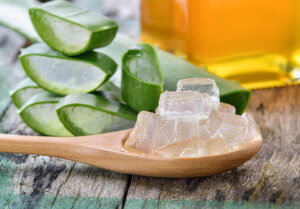
If you want to use pure aloe gel on your skin, there are two main ways to do so.
First, you can buy your own aloe plant and collect the gel as needed. This is undoubtedly the most potent form of aloe because it’s used straight from the plant. Just note that when you cut a leaf open, you’ll want to drain off the yellow liquid (known as latex) and use the pure gel that can be scooped or scraped out.
Though very beneficial, this method of collecting and using aloe is too time-consuming for many people.
The next best option is to buy aloe gel that is made ONLY of pure aloe and a natural preservative. (Because of the high water content of aloe, preservatives are a must for a shelf-stable product.) Also, look for the International Aloe Science Council seal that indicates certification of the quality and quantity of the aloe.
Of course, you can also get incredible benefits by using skincare products that contain aloe.
However, it’s important to look for products that pair clean and non-toxic ingredients with the aloe. Choose USDA Organic skincare for certified chemical-free products, and make sure you can pronounce everything on the label.
Using Aloe for Younger-Looking Skin
If you are searching for anti-aging skincare that features aloe vera, look into the Age-Defying Dream Cream from Purity Woods.
This 100% plant-based cream contains aloe as the very first ingredient and combines it with 25+ other botanical ingredients that are highly effective for erasing the appearance of wrinkles, fine lines, dark spots, and more. The entire formula is USDA Certified Organic, which guarantees no toxic ingredients that will harm your skin.
Head here to learn more about the Age-Defying Dream Cream, and treat your skin to the benefits of the “wonder plant” that is aloe vera.



